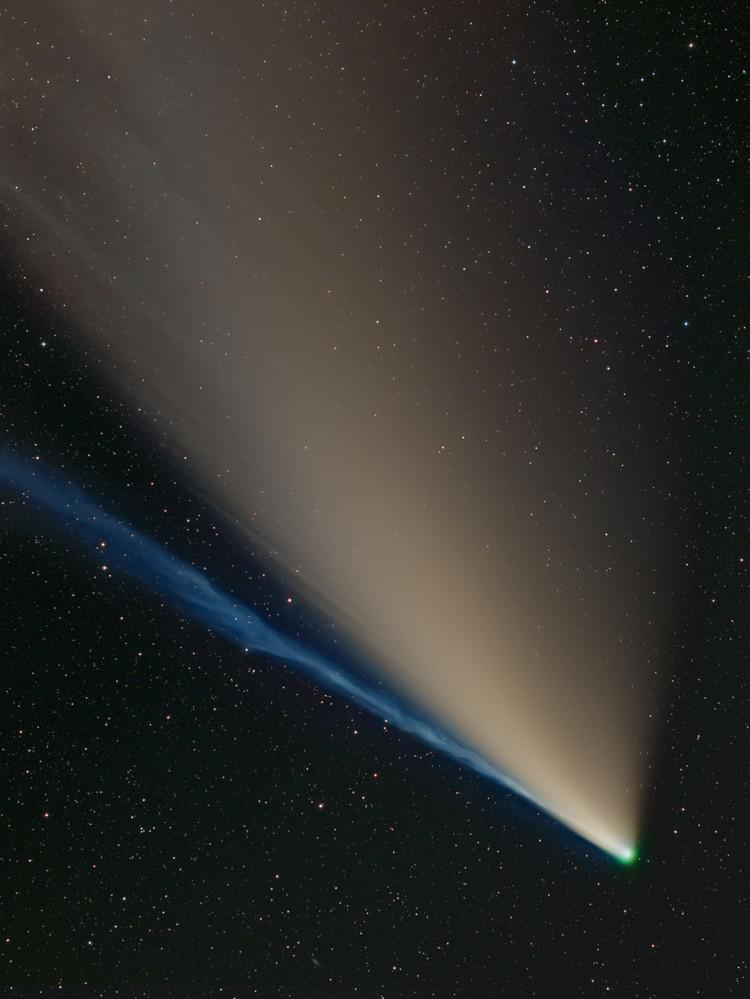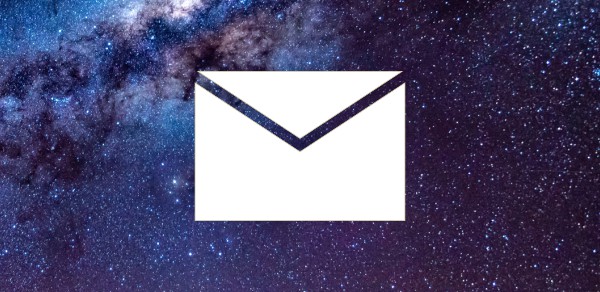This page describes an image Comet C/2020F3 (Neowise) with separate dust and ion gas tails and a green glowing coma, by Dietmar Gutermuth, Germany
Image caption:
Second place in the 2021 IAU OAE Astrophotography Contest, category Comets.
Comets have a very interesting structure comprising of four main parts: the nucleus, composed of rock, dust and frozen gases, typically spanning a few kilometres, although bigger ones have been observed; a small atmosphere of gas surrounding the nucleus (only present when the comet approaches its closest point to the Sun), called coma; and the two distinctive cometary tails (there is at times third tail). The green colour of the coma is due to carbon and nitrogen present in the coma reacting with the Sun’s ultraviolet radiation. The tail that we are mostly used to observing – dust tail and is composed of micron sized dust particles, the second tail composed of charged particles – ion or gas tail. The tails are released only when the comet approaches the Sun at a distance where the heat and radiation emanating from our star is intense enough to vaporize the frozen gases. The dust tail is curved, while the gas tail is straight and always points away from the Sun as this is carried by the solar wind - flow of charged particles emitted by the Sun. As comets are formed by leftover material, they carry with them important information about the early stages of the Solar System’s formation. This beautiful image shows the comet C/2020 F3 (Neowise), as seen from Germany in July 2020, with three of the four structures clearly visible – coma, gas, and dust tail.
Scroll to captions in other languages
Image credit:
Dietmar Gutermuth/IAU OAE
DOI: 10.5281/zenodo.5290341
Related glossary terms:
Comet
, Cometary Coma
, Cometary Tail
Categories:
Solar System
Image license: Creative Commons Attribution 4.0 International (CC BY 4.0) Creative Commons Attribution 4.0 International (CC BY 4.0) icons
The media file captions presented on the OAE website were written, translated and reviewed by a collective effort from the OAE, the OAE Centers and Nodes, the OAE National Astronomy Education Coordinators (NAECs) and other volunteers. You can find a full list of credits for our translation project here. All media file captions are released under a Creative Commons CC BY-4.0 license and should be credited to "IAU OAE". The media files themselves may have different licenses (see above) and should be credited as listed above under "credit".
If you notice a factual error in this caption or an error in any of its translations then please get in touch.
Captions in Different Languages:
Image caption: Secondo posto al Concorso Astrofotografico IAU OAE 2021, categoria Comete.
Le comete hanno una struttura molto interessante che comprende quattro parti principali: il nucleo, composto da roccia, polvere e gas ghiacciati, che si estende tipicamente per qualche chilometro, anche se ne sono state osservate di più grandi; una piccola atmosfera di gas che circonda il nucleo (presente solo quando la cometa si avvicina al punto più vicino al Sole), chiamata chioma; e le due caratteristiche code cometarie (a volte ne esiste una terza). Il colore verde della chioma è dovuto al carbonio e all'azoto presenti nella chioma, che reagiscono con la radiazione ultravioletta del Sole. La coda che siamo perlopiù abituati a osservare è la coda di polvere ed è composta da particelle di polvere di dimensioni dell'ordine dei micron, mentre la seconda coda è composta da particelle cariche - coda di ioni o di gas. Le code vengono rilasciate solo quando la cometa si avvicina al Sole, a una distanza in cui il calore e le radiazioni emanate dalla nostra stella sono abbastanza intense da vaporizzare i gas congelati. La coda di polvere è curva, mentre quella di gas è dritta e punta sempre lontano dal Sole, poiché è trasportata dal vento solare, un flusso di particelle cariche emesse dal Sole. Poiché le comete sono formate da materiale di scarto, portano con sé importanti informazioni sulle prime fasi della formazione del Sistema solare. Questa bella immagine mostra la cometa C/2020 F3 (Neowise), vista dalla Germania nel luglio 2020, con tre delle quattro strutture chiaramente visibili: chioma, gas e coda di polvere.
Image credit: Dietmar Gutermuth/IAU OAE
Related glossary terms: Chioma della cometa , Coda cometaria , Cometa Caption translation status: Approved by a reviewer
Caption translators: Giuliana Giobbi
Caption reviewers: Rodolfo Canestrari
Image caption: 2021 年国际天文学联合会 OAE 天体摄影比赛彗星类第二名。
彗星的结构非常有趣,主要由四个部分组成:由岩石、尘埃和冰冻气体组成的彗核,大小通常为几公里,但也观测到过更大的彗星;彗核周围的一小团气体(只有在彗星最接近太阳时才会出现),称为彗发;以及两条独特的彗尾(有时还有第三条尾)。彗发的绿色是由于其中的碳和氮与太阳的紫外辐射发生反应。我们通常观测到的尾迹是尘埃尾,由微米级的尘埃粒子组成;第二条尾迹由带电粒子组成--即离子尾或气体尾。只有当彗星在一定距离内接近太阳,来自恒星的热量和辐射强到足以使冰冻气体气化时,彗尾才会出现。尘埃尾是弯曲的,而气体尾则是笔直的,并且始终指向远离太阳的方向,因为这是由太阳风携带的--太阳发出的带电粒子流。由于彗星是由残留物质形成的,它们携带着太阳系形成早期的重要信息。这幅美丽的图片显示的是 2020 年 7 月从德国看到的彗星 C/2020 F3(Neowise),四个结构中的三个:彗尾、气体尾和尘埃尾清晰可见。
Image credit: Dietmar Gutermuth/IAU OAE
Related glossary terms: 彗发 , 彗尾 , 彗星 Caption translation status: Not yet approved by a reviewer
Caption translators: Hu Xueying
Image caption: 2021 年國際天文學聯合會 OAE 天體攝影比賽彗星類第二名。
彗星的結構非常有趣,主要由四個部分組成:由岩石、塵埃和冰凍氣體組成的彗核,大小通常為幾公里,但也觀測到過更大的彗星;彗核周圍的一小團氣體(只有在彗星最接近太陽時才會出現),稱為彗發;以及兩條獨特的彗尾(有時還有第三條尾)。彗發的綠色是由於其中的碳和氮與太陽的紫外輻射發生反應。我們通常觀測到的尾跡是塵埃尾,由微米級的塵埃粒子組成;第二條尾跡由帶電粒子組成--即離子尾或氣體尾。只有當彗星在一定距離內接近太陽,來自恆星的熱量和輻射強到足以使冰凍氣體氣化時,彗尾才會出現。塵埃尾是彎曲的,而氣體尾則是筆直的,並且始終指向遠離太陽的方向,因為這是由太陽風攜帶的--太陽發出的帶電粒子流。由於彗星是由殘留物質形成的,它們攜帶著太陽系形成早期的重要信息。這幅美麗的圖片顯示的是 2020 年 7 月從德國看到的彗星 C/2020 F3(Neowise),四個結構中的三個:彗尾、氣體尾和塵埃尾清晰可見。
Image credit: Dietmar Gutermuth/IAU OAE
Related glossary terms: 彗尾 , 彗星 , 彗發 Caption translation status: Not yet approved by a reviewer
Caption translators: An automated transliteration from the simplified Chinese translation by - Hu Xueying









